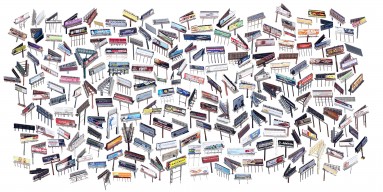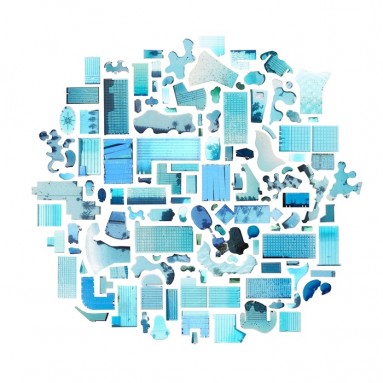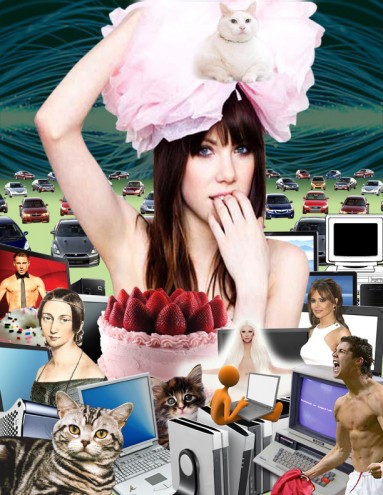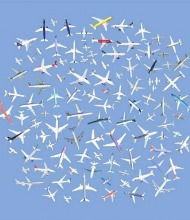An interview with artist of stuff Jenny Odell
Graphic artist Jenny Odell is a self-described satellite tourist. Upon moving to San Francisco for graduate school, she began scouring Google Earth and Street View, hoping to lend definition and a sense of familiar space to her new environment. But what was first a simply utilitarian venture became the fodder for several ongoing works. Odell’s Satellite Collections are collages composed of objects cut from Google Earth and then clustered together into grids. Her subjects are seemingly banal structures normally taken for granted: taxiing airplanes, nuclear cooling towers spewing steam, hundreds upon hundreds of billboards (as seen in her series Signs of Life). But the view from a satellite is not a human perspective, and as Odell gathers these structures en masse, they transform into absurd patterns and become, as she notes in one of her artist statements, “like hieroglyphs that say: people were here.”
In other projects, Odell sifts through the ostensible junk of the internet to uncover quietly devastating narratives. Her book I Hate to Part with It comprises nearly 80 pages of photos from Craigslist ads for jewelry, porcelain figurines, cars, and even animals Craigslist users find themselves forced to sell, accompanied by their often tragic motivations (e.g., “but need to pay some bills,” “but we all have to move on some time,” “but that’s life”). Elsewhere, in the ongoing Popular Images, Odell searches each letter of the alphabet in Google Images, compiling the top suggested results into collages bursting with photos of what fascinates us at that particular moment—Blake Lively, basketball, and babies, to name a few “b”s. The results themselves are only temporary—they would look different every time—capturing the ebb and flow of our pop culture obsessions.
In many ways Odell is just as much an anthropologist as she is an artist. Her collages and grids are essentially studies in human behavior, each a petri dish teeming with data about the way we build and move and the messages we leave behind for ourselves.

Rebecca Bates: What led you to Google Earth-inspired art? Did you begin searching for something in particular, or was this born of an obsession with Google Earth?
Jenny Odell: This started when I was in grad school. I moved from Berkeley to San Francisco, and I’d never really lived in an actual city before. I was trying to understand where I was living, both on Street View and Satellite View. I didn’t think of it as an art thing; I was just trying to figure stuff out. It’s really hard for us to learn a new environment and the information around us. It’s overwhelming. I think the first piece I made was with parking lots. And I also grew up somewhere that is thought of as a parking lot—San Jose. It’s very similar to L.A.; it’s very placeless. It’s not like New York. There’s no grid. It’s just a bunch of sprawl. It started as an attempt to make sense of space.
In your Satellite Collections, why did you choose the objects you chose? Why “97 Nuclear Cooling Towers” or “10 Waterslide Configurations”?
The things I choose have to be man-made and they need to be mundane because I’m trying to pull people into a different perspective on something that they’ve overlooked. That’s why they’re all parking lots or nuclear cooling towers, things that are not considered beautiful.
If you ever fly over the desert you see circular farms, because it’s cheaper to irrigate that way. So I’m working on a collage of those. Lately I’m really into utilities—power plants, waste treatment plants, etc. Also, there’s something about the satellite perspective in general—you can see the way we organize our civilization, for better or worse. You can see that all the trash goes here and the waste goes here, in a way you can’t see when you’re on the ground.
What have you learned about the way we arrange our infrastructures from doing this?
In San Francisco, people think that the San Francisco Dump is where all of the trash ends up, but that’s actually just a transfer station. It all goes to Livermore, which is a weird town no one would ever go to. The dump’s behind a hill--it’s always behind a hill—and they make the road to get there really windy. They don’t want anyone to see it, basically, and I’ve learned that from having to look for landfills. By the end of the process, I got really good at finding them. As I said, for better or worse it makes you realize how much waste there is, the way it’s kept out of everyone’s view and how easy it is to forget about all of that. I’m trying to bring it back to everyone’s view.
Obviously, we never see almost 100 nuclear cooling towers at once, and we almost never see them through the lens of a satellite camera. When a viewer approaches this kind of grid, are they supposed to be struck by the “sameness” of these structures, their banality? Or are you hoping the viewer can parse out the nuances that differentiate each?
For me, it’s about the differences. Especially when researching them, each of the objects almost starts to have a personality. When you put that many things together that are really similar, that is what comes out: the differences. Sometimes my work gets compared to the Bechers (Bernd and Hilla Becher). They’re a famous German artist couple. They would just take pictures of grain silos—just really deadpan, black and white, one after another. And they made a book that’s just grids of silos. It sounds really boring, but after you look at them long enough it starts to get almost funny. You see all of the little nuances, and the silos seem like they have their own personalities.
Your prints have an almost ‘pale-blue-dot’ quality about them. That is, it’s easy to look at our human-made structures and realize their fragility and potential insignificance. What kinds of questions do you hope the viewer asks themselves about their place in the universe?
I definitely try to convey a sense of fragility, the arbitrariness of everything. For example, swimming pools are weird. They’re just boxes of water in the ground. It could easily not have ended up that way. Everything is a specific outcome of a large range of possibilities. I hope that comes across. If you realize that whatever we’ve ended up with is one possibility out of many, it opens up not only the past as a field of possibilities, but also the future. We could organize things very differently, and it could have ended up very differently. I’m trying to break people out of this unquestioning environment, as if there was no choice involved. I hope that people would ask themselves why we have nuclear cooling towers. I’m trying to bring the strangeness to the forefront.

Specifically in the series Signs of Life, not only do you manage to fit about 150 to 300 billboards in each collage, but once a viewer tries to identify each sign (all the Targets, all the McDonalds), the task seems daunting and impossible. What kind of experience are you hoping to invoke in the viewer by overwhelming them this way?
I don’t really think of it as being overwhelming, although obviously I’m the person that’s made it. It’s funny, I just came from this bookstore, and there was a book there called The World in One Cubic Foot, and it’s by a guy [David Liittschwager] who takes an empty cube and puts it somewhere. And everything that enters the cube, he takes a picture of it. For me, when I look at it, it’s like going to an aquarium—that’s how I feel when I look at Signs of Life, like each one is a different species of fish. I started arranging signs that way out of a kind of affection for Liittschwager’s pieces. It’s more of a scientific, curious feeling.
Do you come to any kind of conclusion about the way we communicate with each other having done Signs of Life?
Basically, after you’ve looked at enough of them, you get this meta sense of a funny-sad thing about humanity: half the signs are for junk food, alcohol—there are so many alcohol billboards—gambling, get-rich-quick schemes, etc. And then the other half are about couples counseling and going back to school, adult classes, rehab. You get an overall sense that some people are trying to pull a fast one, but there’s also this very earnest desire to turn one’s life around.
Let’s shift gears a bit and talk about The Popular Images series. You referred to the objects in the Satellite Collections as “hieroglyphs that say: people were here.” If we had to say that each one of the collages in The Popular Images was a hieroglyph, what would they be saying?
I actually consider The Popular Images to be really related to the billboards, content-wise. Hito Steryl has written in defense of “poor images,” these kind of trashy images, which when taken together are almost like humanity talking to itself. It’s an echo chamber, and a lot of it is just garbage. None of those images are really meaningful in and of themselves, but taken together you can see the fascination with that stuff for itself. You can see the effects rather than experiencing the effects of it in real time.
It’s clear there’s an obsession with now-ness. In the collage for the letter C, that’s the only instance that has an historic image, the Clara Schumann portrait. I don’t know if you can really speak to that. It’s just interesting that there’s an obsession with what’s happening now, not really trying to uncover what’s happened in the past.
That weirded me out too. I don’t know why people were looking for her. A lot of the images, there’s some mysterious reason why everyone was looking at it. Just thinking about the logic of the way I make anything, that’s why I like [The World in One Cubic Foot] so much. I basically feel like I work through a filter. Everything I do has all of these rules, it’s like I’m making a net, and I pull it through the internet and come back with something. I don’t know what any of those are going to look like before I do them, because I can’t know what people are thinking. So the fact that Clara Schumann shows up in there, I can’t even control that. Whatever is going on in the world’s echo chambers will show up on that page.

Besides encountering a man in a skeleton shirt, which you reference as a shocking experience in your essay about taking ‘walks’ via Street View, “Ghost in the Machine,” what is the most startling thing you’ve encountered—either something you found while scanning Satellite View or something that came up distorted by the satellite cameras?
That’s basically my entire road trip book. I didn’t have to look far to find weird things like that. The thing I found that literally surprised me the most was a KFC logo (it’s not there anymore in real life). By Area 51, KFC made this logo out of 64,000 plastic tiles on the ground. It can only be viewed from the air—I was just trying to look at Area 51, like everyone. It’s so weird, it looks like an icon on the screen; I tried to click it. I have a screenshot of it, which is weirder now that it’s gone: maybe I’m the only person who has a screenshot of it. If you look up what happened to it, it actually wasn’t there very long. It got blown away in a storm. But it didn’t matter, because it was only meant to be photographed from a satellite in the first place.
It’s just a PR stunt; they just wanted to be able to say they were the first people to do that. They don’t specifically mention it, but I don’t think it’s an accident that it’s next to Area 51. They know people are going to be looking there.
Who are the influences you draw from a lot?
I’m definitely indebted to, and this seems like a weird comparison, John Cage—people from that era, people who really explicitly brought the everyday into a gallery setting in a way that was shocking. That’s a tradition that I’m growing from.
There is a famous photography festival in France every year [Les Rencontres d’Arles]. Two years ago I was in it, and several of my idols were also. But it was very controversial because it’s a photography festival, and no one in the show was a photographer. It was just all reappropriation and a lot of trashy internet stuff, and people were super ruffled by it. But I met a lot of artists that I am inspired by. Specifically, there is this artist Penelope Umbrico, she did Suns (From Sunsets) from Flickr. She just went onto Flickr and found people’s photos of sunsets and cropped them so that the sun’s roughly the same size in all of them and then printed them out on really cheap Walgreen’s 4x6 photo paper. And then she put them all along one wall. It’s really, really bright because it has really saturated color. Everyone takes pictures of sunsets, and everyone composes them more or less the same. There’s just an undying impulse to collectively take pictures of sunsets. But more than that, there is nothing more unitary than the sun. There’s just one sun. It’s like being able to see everyone’s perspective at the same time of the same thing. So Umbrico’s a big influence.
Then there’s Jon Rafman, who does 9 eyes, which is a Street View blog. I know a lot of people do Street View tourism stuff, but I don’t know how he finds some of the things he does. He’ll find white horses running through a graveyard or a house on fire. I think he was one of the first people to really do that seriously, and he has a really good photo essay about what it means to see terrible things from the point of view of a camera that has no soul.
Or, sort of similar, the NY Post cover of the man on the subway tracks right before he gets hit.
Yes, those ethical questions of what it means to be looking at this photograph and the implications of how and when it was taken. And with Street View, there’s a person driving that car. I gave this lecture about the weird, subjective questions about Street View forces people, perhaps not consciously, but at least inadvertently, to deal with. For example, in Rafman’s photo essay, one of the photos is of a prostitute lying facedown in the street. So I went to that address in Street View, and if you look down the street, [Google] just took out that frame. They just quietly removed it. And the thing is, when you’re clicking down the street, it’s really arbitrary how much distance you’re going, so you would not ever know that it’s missing a frame.
Stepping back for a second, what was the response to a show at a photography festival that included no photographers?
There was the familiar criticism, you know, “anyone can do this; this isn’t photography.” But beyond that there was a much bigger emerging question about what’s happening to photography, that photography is having a crisis of meaning—what does it mean to be a photographer when there are security cameras everywhere? People will refer to me as a photographer, but I don’t think of myself as one. In my graduate review, there was a mix-up, and the panelists thought that I was in photography. I passed…but in photography. That was possible because the boundaries are so indeterminate now—when you take a screenshot, you are taking a photo.
And when you compile the grids you’re sort of drawing and sort of sculpting at the same time.
There’s a lot of different comparisons that are made [of me] to natural scientists and collage makers, I guess. There’s something handmade about it; it’s not automated. What I’m doing is hand arranged. I think there are more and more people making work in that gray area.
What are some subjects you’ll be searching for next?
I’m cutting out the second largest coal plant on the planet right now, and it’s almost a combination of All the People and the Satellite Collections. When I started I was choosing subjects because they were mundane and overlooked, but now the more I think about why I’m really doing this, everything starts to seem very fragile. I’m beginning to look at solar fields, fields of just solar panels. It’s crazy, they’re next to farms, so I can see this is where they grow food, and this is where they harvest sun. They’re just things that make you think on a large scale about the planet, and how fragile it is.
Jenny Odell’s work is currently on view at A.I.R. Gallery in Brooklyn and Salon DeHon in San Francisco.

